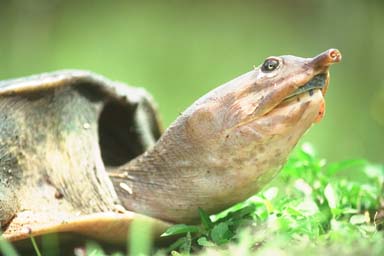
Males have a carapace length and body weight averaging about 35 cm (14 in) and 2.68 kg (5.9 lb) respectively. Adult females are often 3-5 times larger than males. The Florida softshell turtle also exhibits significant sexual size dimorphism. It is also the largest species of softshell turtle found in Florida and all of North America, ranging from 15 to 76 cm (5.9 to 29.9 in) in straight-line carapace length. This color pattern is known as countershading and is a form of camouflage to conceal turtles from potential predators. It is also characterized by a white or cream-colored underside. Ranging from olive green to dark brown, it has the darkest coloration of all the softshell species that inhabit Florida (other species include Apalone mutica calvata and Apalone spinifera aspera). While most turtles have hard shells composed of scutes, the Florida softshell turtle has a cartilaginous carapace covered in leathery skin. The Florida softshell turtle is a large turtle with a flattened, pancake-like body, a long neck, an elongated head with a long snorkel-like nose, and large webbed feet, each with three claws. Ĭlose-up of head of the Florida softshell turtle Description


These different habitats include swamps, lakes, marshes, wet prairies, small rivers, creeks, and even ponds formed in man-made ditches or sinkholes. The Florida softshell turtle is a widespread species and occupies almost every freshwater habitat, even tolerating some brackish environments however, it is not often found in water with strong currents, preferring habitats with slow-moving or still water. Of the three species in the genus Apalone, the Florida softshell turtle occupies the smallest geographic range. It is the only species of softshell turtle whose range spans the entire Florida peninsula. The Florida softshell turtle is found primarily in the state of Florida, but it also ranges to southern sections of Alabama, Georgia, and South Carolina. The species is native to the Southeastern United States. The Florida softshell turtle ( Apalone ferox) is a species of turtle in the family Trionychidae. Testudo brongniartii Gray, 1831 ( ex errore).We use the arsenal of Materials Science characterization techniques to probe the structure of the shell and explain its amazing structure and capacity for flexing, while retaining its protection capability.įinite element analysis Leatherback turtle Mechanical properties Suture.Ĭopyright © 2015 Acta Materialia Inc.
#Hard shell seaturtle skin
This is enabled by the flexibility between the bony plates comprising its shell, which is covered by a skin and not by hard keratin as all other turtles. This first study of the structure of its shell provides important new insights that explain its amazing capacity for diving: depths of over 1,000 m have been recorded. The leatherback turtle is a magnificent chelonian whose decreasing numbers have brought it to the brink of extinction in the Pacific Ocean. A calculation is developed to quantify the flexibility of the carapace and plastron as a function of the angular displacement at the sutures, predicting the interdependence between geometrical parameters and flexibility. The sutures have a triangular shape with an angle of ∼30° which provides a balance between the tensile strength of the osteoderms and shear strength of the collagen fiber layer and is verified by Li-Ortiz-Boyce in a previous study. The angle of interpenetration at the suture of osteoderms is analyzed and compared with analytical predictions. The compressive strength is highly anisotropic by virtue of the interaction between loading orientation and arrangement of porous and compact components of osteoderms. They both are bony structures with a porous core sandwiched between compact layers that form the outside and inside surfaces. The structure of the two types of osteoderms is characterized and their mechanical properties are investigated with particular attention to the failure mechanisms.

The osteoderms are of two types: flat and ridged. The leatherback turtle has ridges along the carapace to enhance the hydrodynamic flow and provide a tailored stiffness. This design allows the body to contract better than a hard-shelled sea turtle as it dives to depths of over 1,000 m. The soft dermis and suture geometry enable a significant amount of flexing of the junction between adjacent osteoderms. The osteoderm is composed of bony plates that are interconnected with collagen fibers in a structure called suture. The leatherback sea turtle is unique among chelonians for having a soft skin which covers its osteoderms.


 0 kommentar(er)
0 kommentar(er)
